Detailed Analysis of Regina v Bewley: Criminal Law and Firearms Act
VerifiedAdded on 2022/11/19
|8
|1680
|166
Case Study
AI Summary
This case study analyzes the criminal law case of Regina v Bewley, focusing on the interpretation of the Firearms Act 1968. The defendant, found in possession of a modified starting pistol, was initially convicted under s. 5(1)(aba) of the Act. The case explores whether the pistol, capable of firing a missile, qualified as a prohibited firearm. The procedural history involves an appeal against the conviction, with the appellate court ultimately determining that the starting pistol did not meet the criteria of a prohibited firearm as it could not be readily converted into a firearm without special skills or tools beyond those in common use. The court referenced prior cases like Cafferata v Wilson and R v Panenell to support its decision, emphasizing that the Firearms Act must be applied as a comprehensive code and that the prosecution failed to prove the pistol fell under the 1982 Act. The appeal was granted, and the conviction was set aside, with the court also allowing the defendant to appeal against the sentence. The case highlights the importance of precise statutory interpretation and the need for the prosecution to provide sufficient evidence to prove that an item falls under the scope of firearms legislation.
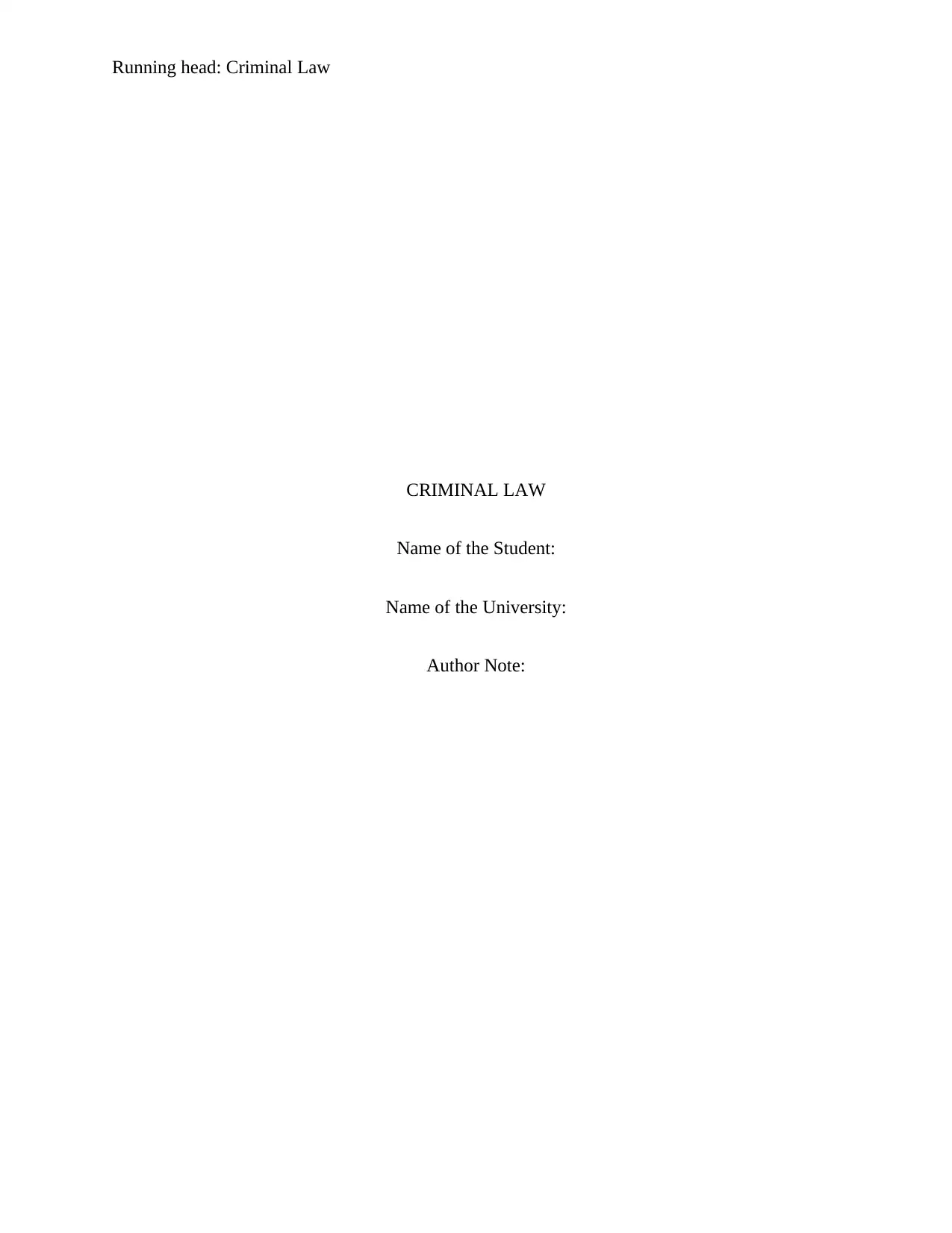
Running head: Criminal Law
CRIMINAL LAW
Name of the Student:
Name of the University:
Author Note:
CRIMINAL LAW
Name of the Student:
Name of the University:
Author Note:
Paraphrase This Document
Need a fresh take? Get an instant paraphrase of this document with our AI Paraphraser
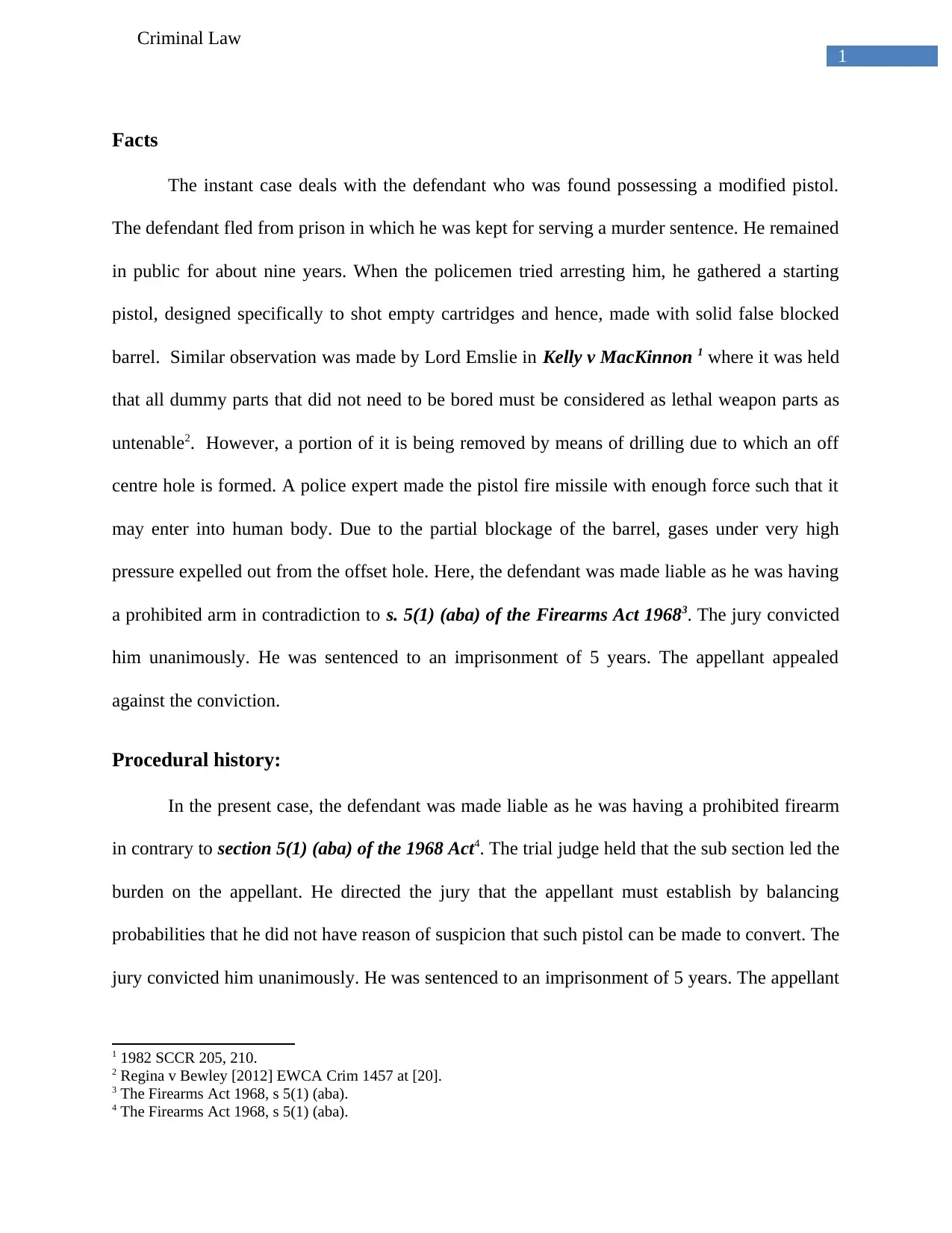
1
Criminal Law
Facts
The instant case deals with the defendant who was found possessing a modified pistol.
The defendant fled from prison in which he was kept for serving a murder sentence. He remained
in public for about nine years. When the policemen tried arresting him, he gathered a starting
pistol, designed specifically to shot empty cartridges and hence, made with solid false blocked
barrel. Similar observation was made by Lord Emslie in Kelly v MacKinnon 1 where it was held
that all dummy parts that did not need to be bored must be considered as lethal weapon parts as
untenable2. However, a portion of it is being removed by means of drilling due to which an off
centre hole is formed. A police expert made the pistol fire missile with enough force such that it
may enter into human body. Due to the partial blockage of the barrel, gases under very high
pressure expelled out from the offset hole. Here, the defendant was made liable as he was having
a prohibited arm in contradiction to s. 5(1) (aba) of the Firearms Act 19683. The jury convicted
him unanimously. He was sentenced to an imprisonment of 5 years. The appellant appealed
against the conviction.
Procedural history:
In the present case, the defendant was made liable as he was having a prohibited firearm
in contrary to section 5(1) (aba) of the 1968 Act4. The trial judge held that the sub section led the
burden on the appellant. He directed the jury that the appellant must establish by balancing
probabilities that he did not have reason of suspicion that such pistol can be made to convert. The
jury convicted him unanimously. He was sentenced to an imprisonment of 5 years. The appellant
1 1982 SCCR 205, 210.
2 Regina v Bewley [2012] EWCA Crim 1457 at [20].
3 The Firearms Act 1968, s 5(1) (aba).
4 The Firearms Act 1968, s 5(1) (aba).
Criminal Law
Facts
The instant case deals with the defendant who was found possessing a modified pistol.
The defendant fled from prison in which he was kept for serving a murder sentence. He remained
in public for about nine years. When the policemen tried arresting him, he gathered a starting
pistol, designed specifically to shot empty cartridges and hence, made with solid false blocked
barrel. Similar observation was made by Lord Emslie in Kelly v MacKinnon 1 where it was held
that all dummy parts that did not need to be bored must be considered as lethal weapon parts as
untenable2. However, a portion of it is being removed by means of drilling due to which an off
centre hole is formed. A police expert made the pistol fire missile with enough force such that it
may enter into human body. Due to the partial blockage of the barrel, gases under very high
pressure expelled out from the offset hole. Here, the defendant was made liable as he was having
a prohibited arm in contradiction to s. 5(1) (aba) of the Firearms Act 19683. The jury convicted
him unanimously. He was sentenced to an imprisonment of 5 years. The appellant appealed
against the conviction.
Procedural history:
In the present case, the defendant was made liable as he was having a prohibited firearm
in contrary to section 5(1) (aba) of the 1968 Act4. The trial judge held that the sub section led the
burden on the appellant. He directed the jury that the appellant must establish by balancing
probabilities that he did not have reason of suspicion that such pistol can be made to convert. The
jury convicted him unanimously. He was sentenced to an imprisonment of 5 years. The appellant
1 1982 SCCR 205, 210.
2 Regina v Bewley [2012] EWCA Crim 1457 at [20].
3 The Firearms Act 1968, s 5(1) (aba).
4 The Firearms Act 1968, s 5(1) (aba).
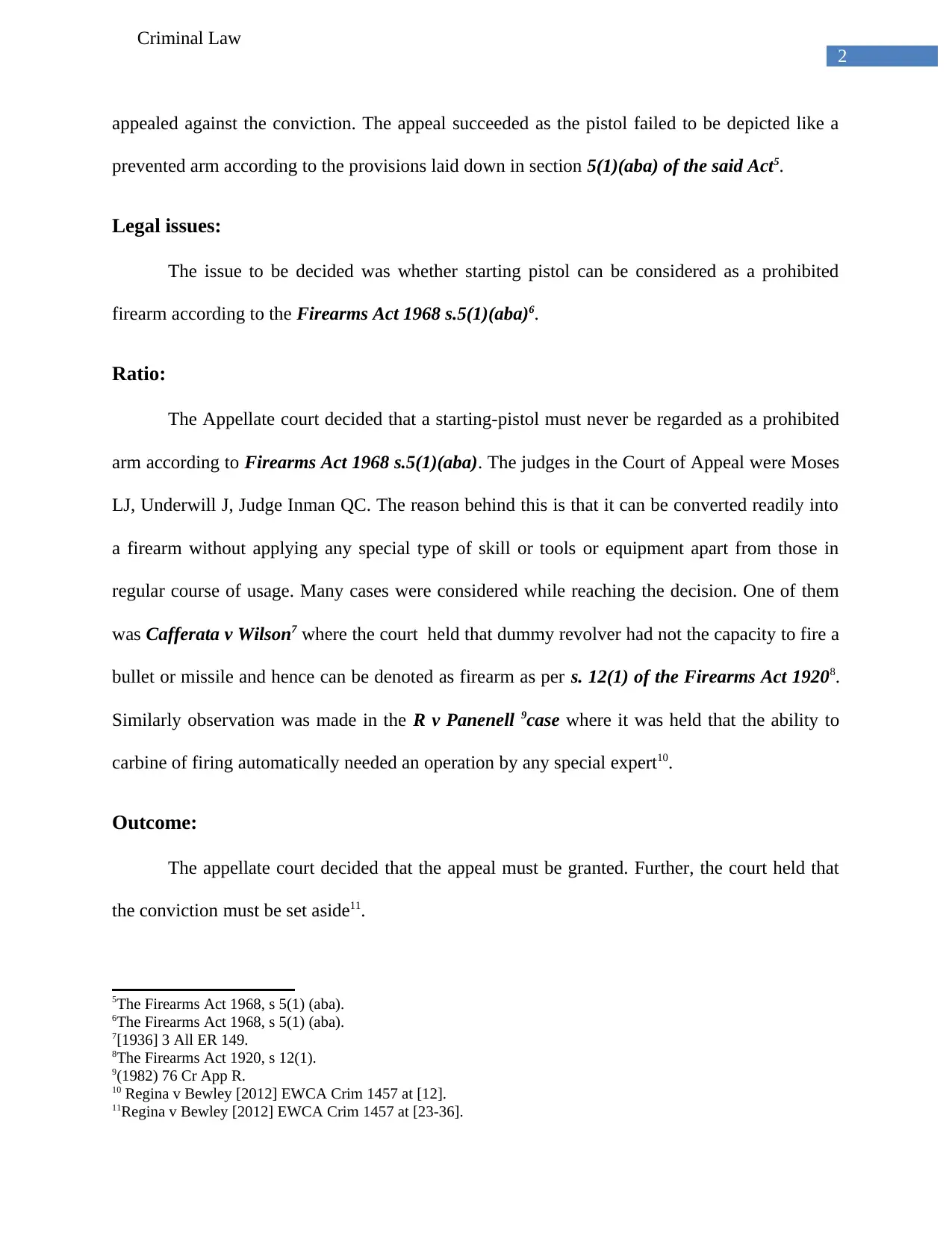
2
Criminal Law
appealed against the conviction. The appeal succeeded as the pistol failed to be depicted like a
prevented arm according to the provisions laid down in section 5(1)(aba) of the said Act5.
Legal issues:
The issue to be decided was whether starting pistol can be considered as a prohibited
firearm according to the Firearms Act 1968 s.5(1)(aba)6.
Ratio:
The Appellate court decided that a starting-pistol must never be regarded as a prohibited
arm according to Firearms Act 1968 s.5(1)(aba). The judges in the Court of Appeal were Moses
LJ, Underwill J, Judge Inman QC. The reason behind this is that it can be converted readily into
a firearm without applying any special type of skill or tools or equipment apart from those in
regular course of usage. Many cases were considered while reaching the decision. One of them
was Cafferata v Wilson7 where the court held that dummy revolver had not the capacity to fire a
bullet or missile and hence can be denoted as firearm as per s. 12(1) of the Firearms Act 19208.
Similarly observation was made in the R v Panenell 9case where it was held that the ability to
carbine of firing automatically needed an operation by any special expert10.
Outcome:
The appellate court decided that the appeal must be granted. Further, the court held that
the conviction must be set aside11.
5The Firearms Act 1968, s 5(1) (aba).
6The Firearms Act 1968, s 5(1) (aba).
7[1936] 3 All ER 149.
8The Firearms Act 1920, s 12(1).
9(1982) 76 Cr App R.
10 Regina v Bewley [2012] EWCA Crim 1457 at [12].
11Regina v Bewley [2012] EWCA Crim 1457 at [23-36].
Criminal Law
appealed against the conviction. The appeal succeeded as the pistol failed to be depicted like a
prevented arm according to the provisions laid down in section 5(1)(aba) of the said Act5.
Legal issues:
The issue to be decided was whether starting pistol can be considered as a prohibited
firearm according to the Firearms Act 1968 s.5(1)(aba)6.
Ratio:
The Appellate court decided that a starting-pistol must never be regarded as a prohibited
arm according to Firearms Act 1968 s.5(1)(aba). The judges in the Court of Appeal were Moses
LJ, Underwill J, Judge Inman QC. The reason behind this is that it can be converted readily into
a firearm without applying any special type of skill or tools or equipment apart from those in
regular course of usage. Many cases were considered while reaching the decision. One of them
was Cafferata v Wilson7 where the court held that dummy revolver had not the capacity to fire a
bullet or missile and hence can be denoted as firearm as per s. 12(1) of the Firearms Act 19208.
Similarly observation was made in the R v Panenell 9case where it was held that the ability to
carbine of firing automatically needed an operation by any special expert10.
Outcome:
The appellate court decided that the appeal must be granted. Further, the court held that
the conviction must be set aside11.
5The Firearms Act 1968, s 5(1) (aba).
6The Firearms Act 1968, s 5(1) (aba).
7[1936] 3 All ER 149.
8The Firearms Act 1920, s 12(1).
9(1982) 76 Cr App R.
10 Regina v Bewley [2012] EWCA Crim 1457 at [12].
11Regina v Bewley [2012] EWCA Crim 1457 at [23-36].
⊘ This is a preview!⊘
Do you want full access?
Subscribe today to unlock all pages.

Trusted by 1+ million students worldwide
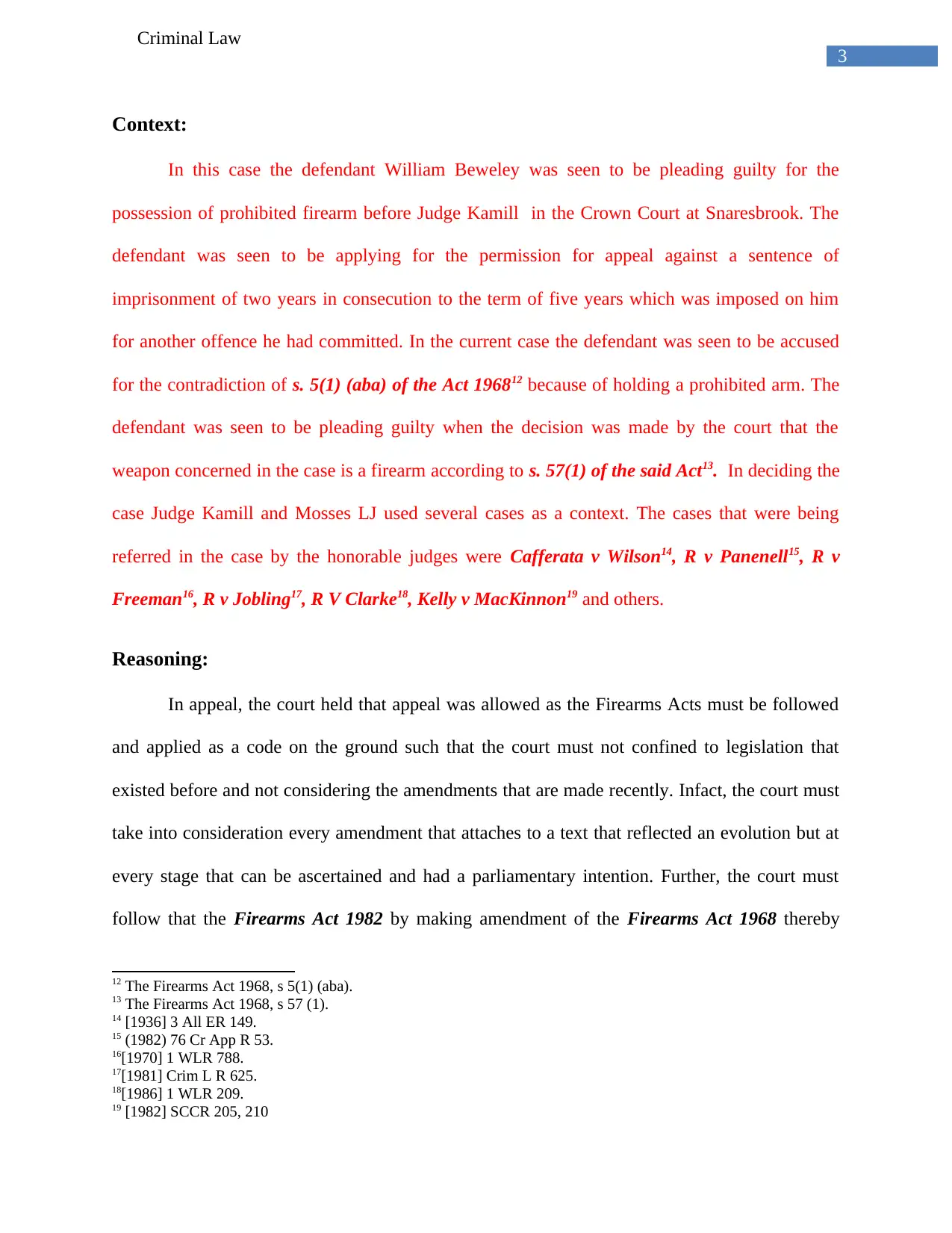
3
Criminal Law
Context:
In this case the defendant William Beweley was seen to be pleading guilty for the
possession of prohibited firearm before Judge Kamill in the Crown Court at Snaresbrook. The
defendant was seen to be applying for the permission for appeal against a sentence of
imprisonment of two years in consecution to the term of five years which was imposed on him
for another offence he had committed. In the current case the defendant was seen to be accused
for the contradiction of s. 5(1) (aba) of the Act 196812 because of holding a prohibited arm. The
defendant was seen to be pleading guilty when the decision was made by the court that the
weapon concerned in the case is a firearm according to s. 57(1) of the said Act13. In deciding the
case Judge Kamill and Mosses LJ used several cases as a context. The cases that were being
referred in the case by the honorable judges were Cafferata v Wilson14, R v Panenell15, R v
Freeman16, R v Jobling17, R V Clarke18, Kelly v MacKinnon19 and others.
Reasoning:
In appeal, the court held that appeal was allowed as the Firearms Acts must be followed
and applied as a code on the ground such that the court must not confined to legislation that
existed before and not considering the amendments that are made recently. Infact, the court must
take into consideration every amendment that attaches to a text that reflected an evolution but at
every stage that can be ascertained and had a parliamentary intention. Further, the court must
follow that the Firearms Act 1982 by making amendment of the Firearms Act 1968 thereby
12 The Firearms Act 1968, s 5(1) (aba).
13 The Firearms Act 1968, s 57 (1).
14 [1936] 3 All ER 149.
15 (1982) 76 Cr App R 53.
16[1970] 1 WLR 788.
17[1981] Crim L R 625.
18[1986] 1 WLR 209.
19 [1982] SCCR 205, 210
Criminal Law
Context:
In this case the defendant William Beweley was seen to be pleading guilty for the
possession of prohibited firearm before Judge Kamill in the Crown Court at Snaresbrook. The
defendant was seen to be applying for the permission for appeal against a sentence of
imprisonment of two years in consecution to the term of five years which was imposed on him
for another offence he had committed. In the current case the defendant was seen to be accused
for the contradiction of s. 5(1) (aba) of the Act 196812 because of holding a prohibited arm. The
defendant was seen to be pleading guilty when the decision was made by the court that the
weapon concerned in the case is a firearm according to s. 57(1) of the said Act13. In deciding the
case Judge Kamill and Mosses LJ used several cases as a context. The cases that were being
referred in the case by the honorable judges were Cafferata v Wilson14, R v Panenell15, R v
Freeman16, R v Jobling17, R V Clarke18, Kelly v MacKinnon19 and others.
Reasoning:
In appeal, the court held that appeal was allowed as the Firearms Acts must be followed
and applied as a code on the ground such that the court must not confined to legislation that
existed before and not considering the amendments that are made recently. Infact, the court must
take into consideration every amendment that attaches to a text that reflected an evolution but at
every stage that can be ascertained and had a parliamentary intention. Further, the court must
follow that the Firearms Act 1982 by making amendment of the Firearms Act 1968 thereby
12 The Firearms Act 1968, s 5(1) (aba).
13 The Firearms Act 1968, s 57 (1).
14 [1936] 3 All ER 149.
15 (1982) 76 Cr App R 53.
16[1970] 1 WLR 788.
17[1981] Crim L R 625.
18[1986] 1 WLR 209.
19 [1982] SCCR 205, 210
Paraphrase This Document
Need a fresh take? Get an instant paraphrase of this document with our AI Paraphraser
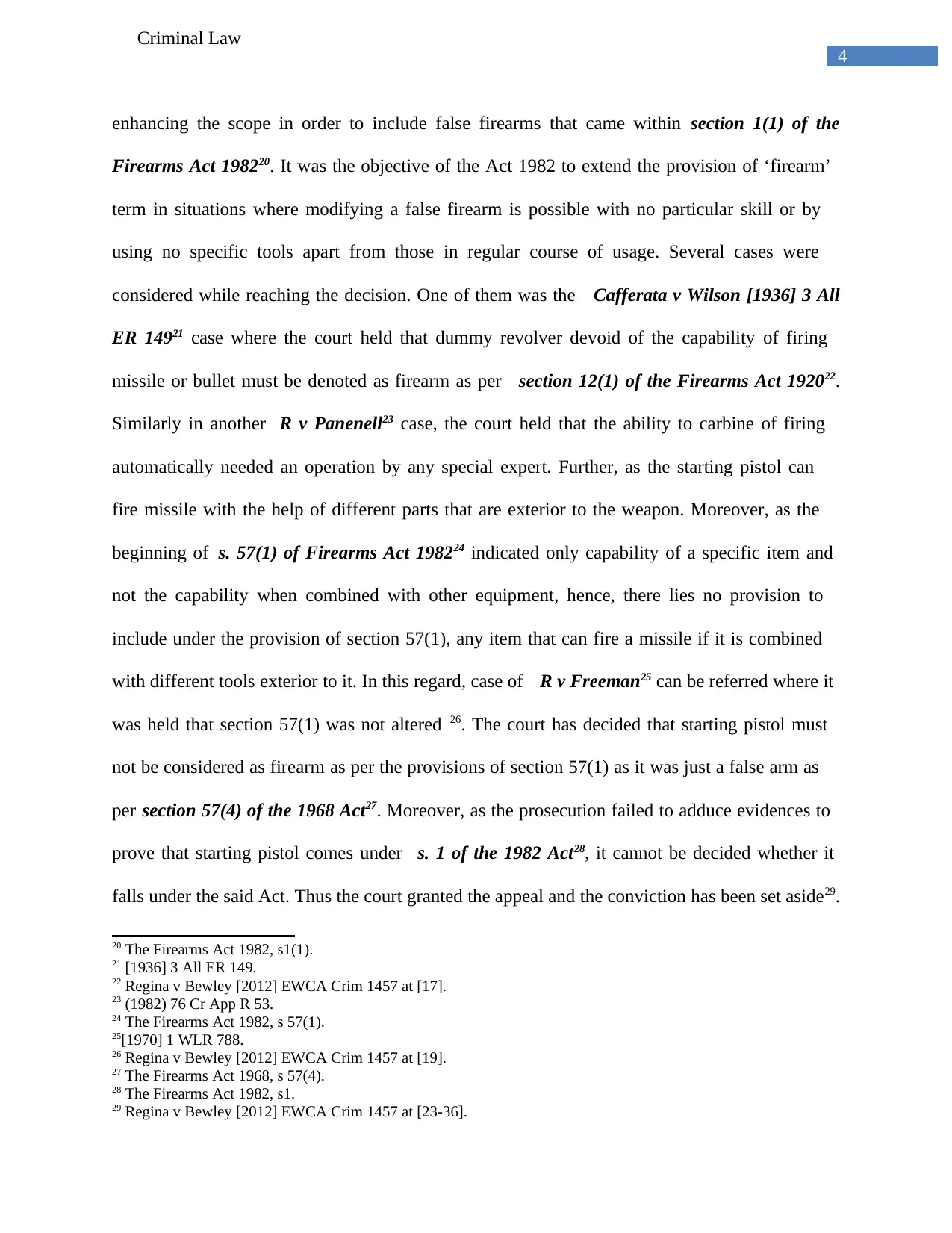
4
Criminal Law
enhancing the scope in order to include false firearms that came within section 1(1) of the
Firearms Act 198220. It was the objective of the Act 1982 to extend the provision of ‘firearm’
term in situations where modifying a false firearm is possible with no particular skill or by
using no specific tools apart from those in regular course of usage. Several cases were
considered while reaching the decision. One of them was the Cafferata v Wilson [1936] 3 All
ER 14921 case where the court held that dummy revolver devoid of the capability of firing
missile or bullet must be denoted as firearm as per section 12(1) of the Firearms Act 192022.
Similarly in another R v Panenell23 case, the court held that the ability to carbine of firing
automatically needed an operation by any special expert. Further, as the starting pistol can
fire missile with the help of different parts that are exterior to the weapon. Moreover, as the
beginning of s. 57(1) of Firearms Act 198224 indicated only capability of a specific item and
not the capability when combined with other equipment, hence, there lies no provision to
include under the provision of section 57(1), any item that can fire a missile if it is combined
with different tools exterior to it. In this regard, case of R v Freeman25 can be referred where it
was held that section 57(1) was not altered 26. The court has decided that starting pistol must
not be considered as firearm as per the provisions of section 57(1) as it was just a false arm as
per section 57(4) of the 1968 Act27. Moreover, as the prosecution failed to adduce evidences to
prove that starting pistol comes under s. 1 of the 1982 Act28, it cannot be decided whether it
falls under the said Act. Thus the court granted the appeal and the conviction has been set aside29.
20 The Firearms Act 1982, s1(1).
21 [1936] 3 All ER 149.
22 Regina v Bewley [2012] EWCA Crim 1457 at [17].
23 (1982) 76 Cr App R 53.
24 The Firearms Act 1982, s 57(1).
25[1970] 1 WLR 788.
26 Regina v Bewley [2012] EWCA Crim 1457 at [19].
27 The Firearms Act 1968, s 57(4).
28 The Firearms Act 1982, s1.
29 Regina v Bewley [2012] EWCA Crim 1457 at [23-36].
Criminal Law
enhancing the scope in order to include false firearms that came within section 1(1) of the
Firearms Act 198220. It was the objective of the Act 1982 to extend the provision of ‘firearm’
term in situations where modifying a false firearm is possible with no particular skill or by
using no specific tools apart from those in regular course of usage. Several cases were
considered while reaching the decision. One of them was the Cafferata v Wilson [1936] 3 All
ER 14921 case where the court held that dummy revolver devoid of the capability of firing
missile or bullet must be denoted as firearm as per section 12(1) of the Firearms Act 192022.
Similarly in another R v Panenell23 case, the court held that the ability to carbine of firing
automatically needed an operation by any special expert. Further, as the starting pistol can
fire missile with the help of different parts that are exterior to the weapon. Moreover, as the
beginning of s. 57(1) of Firearms Act 198224 indicated only capability of a specific item and
not the capability when combined with other equipment, hence, there lies no provision to
include under the provision of section 57(1), any item that can fire a missile if it is combined
with different tools exterior to it. In this regard, case of R v Freeman25 can be referred where it
was held that section 57(1) was not altered 26. The court has decided that starting pistol must
not be considered as firearm as per the provisions of section 57(1) as it was just a false arm as
per section 57(4) of the 1968 Act27. Moreover, as the prosecution failed to adduce evidences to
prove that starting pistol comes under s. 1 of the 1982 Act28, it cannot be decided whether it
falls under the said Act. Thus the court granted the appeal and the conviction has been set aside29.
20 The Firearms Act 1982, s1(1).
21 [1936] 3 All ER 149.
22 Regina v Bewley [2012] EWCA Crim 1457 at [17].
23 (1982) 76 Cr App R 53.
24 The Firearms Act 1982, s 57(1).
25[1970] 1 WLR 788.
26 Regina v Bewley [2012] EWCA Crim 1457 at [19].
27 The Firearms Act 1968, s 57(4).
28 The Firearms Act 1982, s1.
29 Regina v Bewley [2012] EWCA Crim 1457 at [23-36].

5
Criminal Law
Some other cases that were followed to reach the decision of this case were R v Jobling30, R V
Clarke31 and others32.
Impact
It was rightly observed that the language of the s. 57(1) of the 1968 Act33 had been
widely drawn for the ‘public policy reasons’. It was concluded by the judges that provisions of
the 1920 Act had been re-enacted in a slightly different language by the 1937 and 1968 Firearms
Acts. It can be concluded that the application of the principles of the 1937 and the 1968 Acts
should be enacted by the legislature of the states where the law is actually from and by the dates
when they had been passed by the practice of the courts. The question was raised whether the
gun in the current case could be seen to be falling under the meaning of firearm under the
provision of s. 5(1) (aba) of the Act 196834. This was answered in the case by citing the facts
from Kelly v MacKinnon35where the Lord-Justice General criticized and declined to follow the
case Cafferata v Wilson36 where it was decided that a replica of Colt revolver could be easily
converted in a firearm would not come under the meaning of section 57(1) of the 1968 Act37.
The court further stated that the Act of 1968 needs to be amended and the principle that had been
identified in the Freeman case under the statutory scheme is not applicable any longer. The
appellate court quashed the sentence of conviction. The defendant was also allowed to appeal
against decision of 2 years imprisonment that had been passed along with the sentence of 5 years
30[1981] Crim L R 625.
31[1986] 1 WLR 209.
32 Regina v Bewley [2012] EWCA Crim 1457 at [14].
33 The Firearms Act 1968, s 57 (1).
34 The Firearms Act 1968, s 5(1) (aba).
35 [1982] SCCR 205, 210
36 [1936] 3 All ER 149.
37 The Firearms Act 1968, s 57(1).
Criminal Law
Some other cases that were followed to reach the decision of this case were R v Jobling30, R V
Clarke31 and others32.
Impact
It was rightly observed that the language of the s. 57(1) of the 1968 Act33 had been
widely drawn for the ‘public policy reasons’. It was concluded by the judges that provisions of
the 1920 Act had been re-enacted in a slightly different language by the 1937 and 1968 Firearms
Acts. It can be concluded that the application of the principles of the 1937 and the 1968 Acts
should be enacted by the legislature of the states where the law is actually from and by the dates
when they had been passed by the practice of the courts. The question was raised whether the
gun in the current case could be seen to be falling under the meaning of firearm under the
provision of s. 5(1) (aba) of the Act 196834. This was answered in the case by citing the facts
from Kelly v MacKinnon35where the Lord-Justice General criticized and declined to follow the
case Cafferata v Wilson36 where it was decided that a replica of Colt revolver could be easily
converted in a firearm would not come under the meaning of section 57(1) of the 1968 Act37.
The court further stated that the Act of 1968 needs to be amended and the principle that had been
identified in the Freeman case under the statutory scheme is not applicable any longer. The
appellate court quashed the sentence of conviction. The defendant was also allowed to appeal
against decision of 2 years imprisonment that had been passed along with the sentence of 5 years
30[1981] Crim L R 625.
31[1986] 1 WLR 209.
32 Regina v Bewley [2012] EWCA Crim 1457 at [14].
33 The Firearms Act 1968, s 57 (1).
34 The Firearms Act 1968, s 5(1) (aba).
35 [1982] SCCR 205, 210
36 [1936] 3 All ER 149.
37 The Firearms Act 1968, s 57(1).
⊘ This is a preview!⊘
Do you want full access?
Subscribe today to unlock all pages.

Trusted by 1+ million students worldwide

6
Criminal Law
conviction38. The judges held that “the appeal would be allowed and the conviction quashed
(post, paras 23-36)39.
38 Regina v Bewley [2012] EWCA Crim 1457 at [40].
39 Regina v Bewley [2012] EWCA Crim 1457 at [23-36].
Criminal Law
conviction38. The judges held that “the appeal would be allowed and the conviction quashed
(post, paras 23-36)39.
38 Regina v Bewley [2012] EWCA Crim 1457 at [40].
39 Regina v Bewley [2012] EWCA Crim 1457 at [23-36].
Paraphrase This Document
Need a fresh take? Get an instant paraphrase of this document with our AI Paraphraser
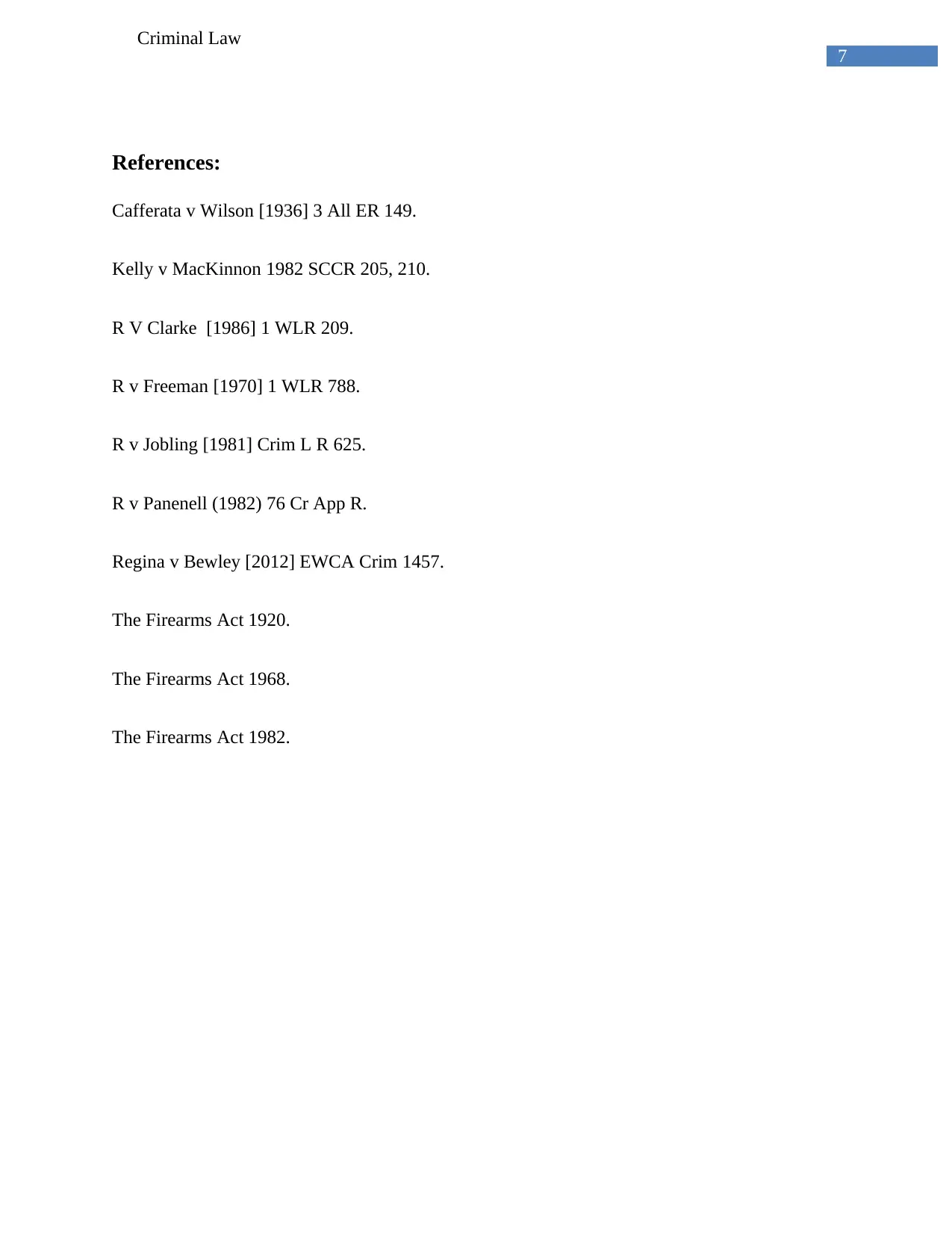
7
Criminal Law
References:
Cafferata v Wilson [1936] 3 All ER 149.
Kelly v MacKinnon 1982 SCCR 205, 210.
R V Clarke [1986] 1 WLR 209.
R v Freeman [1970] 1 WLR 788.
R v Jobling [1981] Crim L R 625.
R v Panenell (1982) 76 Cr App R.
Regina v Bewley [2012] EWCA Crim 1457.
The Firearms Act 1920.
The Firearms Act 1968.
The Firearms Act 1982.
Criminal Law
References:
Cafferata v Wilson [1936] 3 All ER 149.
Kelly v MacKinnon 1982 SCCR 205, 210.
R V Clarke [1986] 1 WLR 209.
R v Freeman [1970] 1 WLR 788.
R v Jobling [1981] Crim L R 625.
R v Panenell (1982) 76 Cr App R.
Regina v Bewley [2012] EWCA Crim 1457.
The Firearms Act 1920.
The Firearms Act 1968.
The Firearms Act 1982.
1 out of 8
Your All-in-One AI-Powered Toolkit for Academic Success.
+13062052269
info@desklib.com
Available 24*7 on WhatsApp / Email
![[object Object]](/_next/static/media/star-bottom.7253800d.svg)
Unlock your academic potential
Copyright © 2020–2025 A2Z Services. All Rights Reserved. Developed and managed by ZUCOL.


